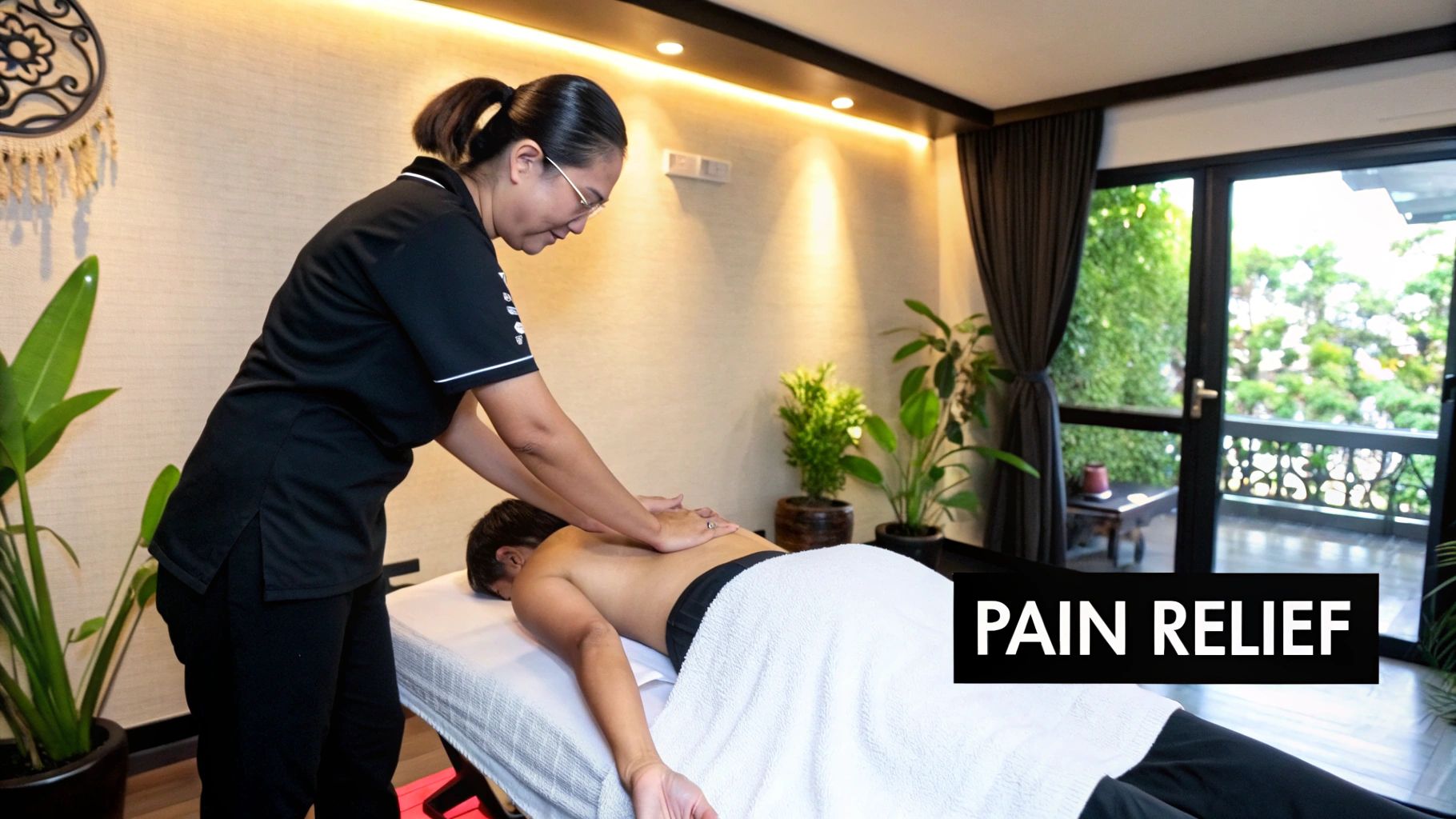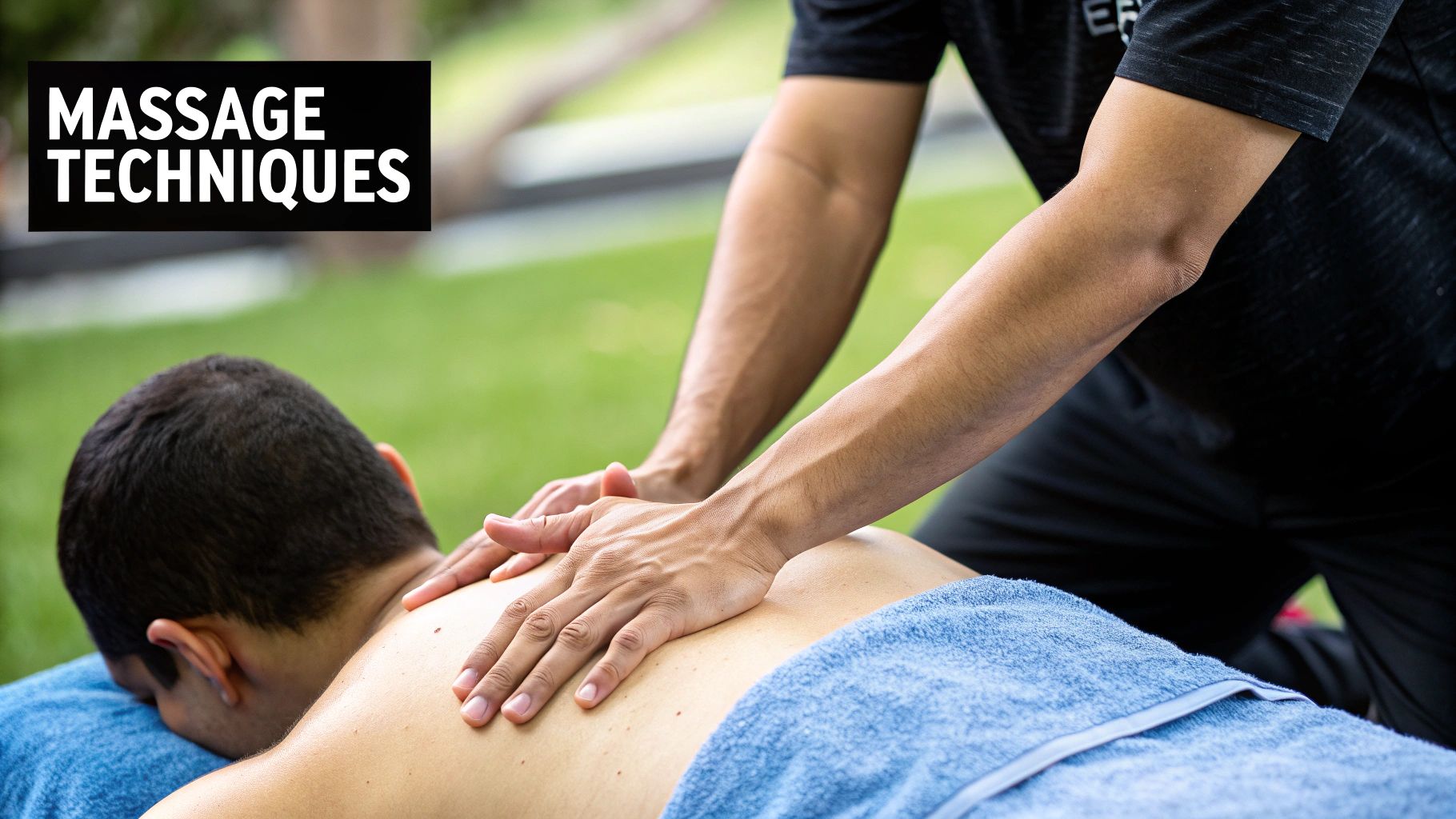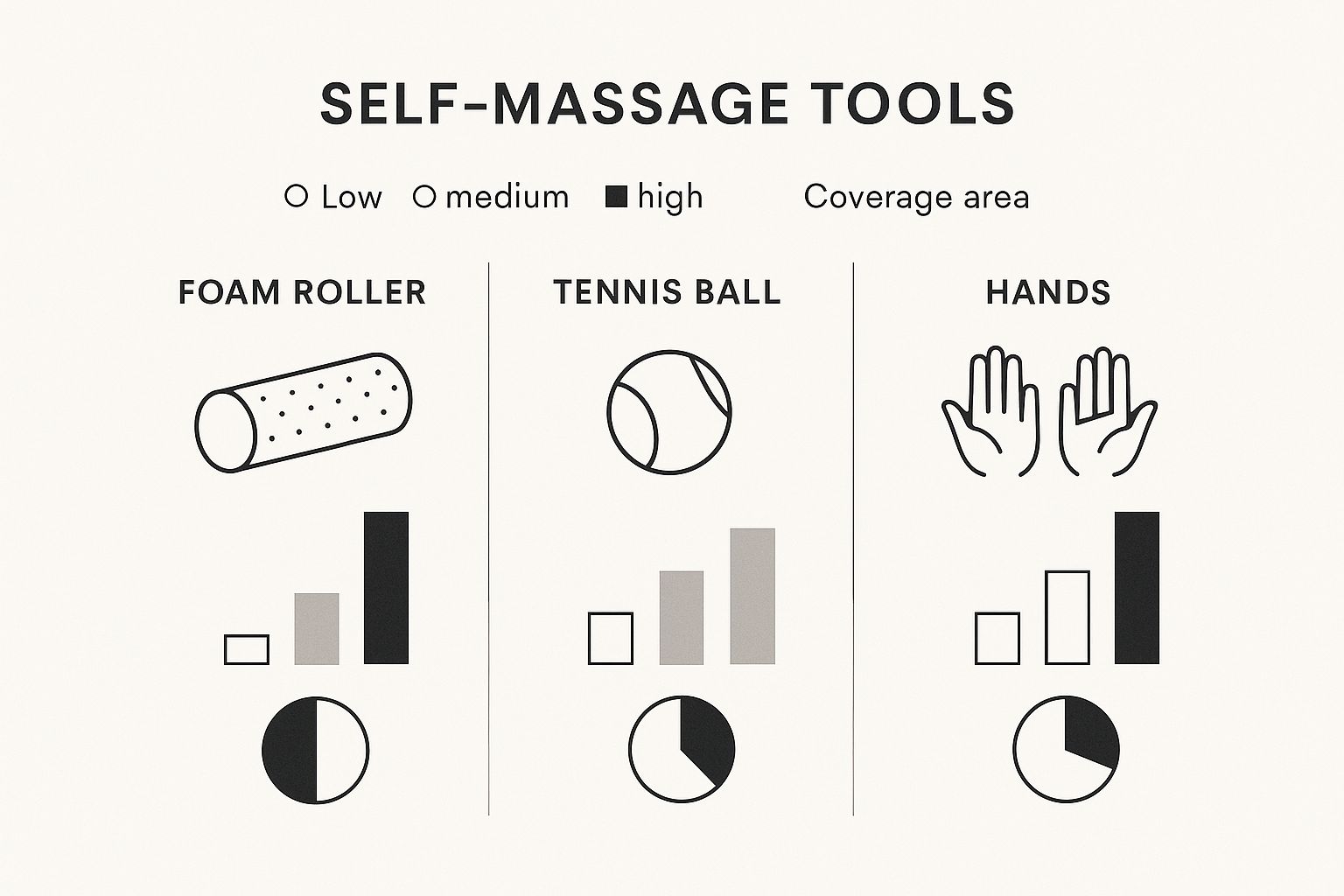Massage for Back Pain Relief: Find Lasting Comfort

If you've ever found yourself wondering whether a massage can really do anything for your back pain, you're not alone. The simple answer is yes, absolutely. It's more than just a feel-good luxury; a proper massage triggers real, beneficial changes in your body to fight pain, melt away chronic tension, and help injured muscles heal. It's a time-tested, hands-on path to finding genuine relief.
How Massage Actually Works to Relieve Back Pain

When your back starts aching, what's your first instinct? For most of us, it's to rub the sore spot. That simple, intuitive action is a window into the powerful science behind professional massage therapy. It’s not just wishful thinking—there are concrete reasons why massage is so effective for everything from a sudden twinge to persistent, nagging discomfort.
The scale of back pain is just staggering. In 2020, it affected 619 million people around the globe, and experts predict that number could swell to 843 million by 2050. It's no wonder that in the U.S., nearly 43% of people who get a massage are doing it for health reasons like pain management.
To help you understand exactly how it works, here's a quick summary of the main ways massage therapy helps ease back pain.
Quick Overview of How Massage Eases Back Pain
| Mechanism | How It Relieves Back Pain |
|---|---|
| Increased Circulation | Delivers fresh, oxygen-rich blood to tight muscles, flushing out inflammatory waste products that cause soreness. |
| Muscle Relaxation | Manually softens and lengthens tense muscle fibers, breaking the "pain-spasm-pain" cycle of chronic discomfort. |
| Endorphin Release | Triggers the body's natural painkillers and mood elevators, offering immediate pain relief and a sense of well-being. |
| Reduced Cortisol | Lowers levels of the stress hormone cortisol, which can otherwise increase muscle tension and pain sensitivity. |
Let's dive a little deeper into these points.
Boosting Blood Flow to Heal and Soothe
One of the most immediate benefits of massage is how it jump-starts circulation. When your muscles are tight and knotted up, blood flow gets restricted. Think of it like a traffic jam on a highway—nothing can get through efficiently. This slowdown traps metabolic waste and prevents healing nutrients from reaching the tissue.
A massage therapist acts like a traffic controller, physically manipulating the tissue to break up that congestion. The pressure and gliding strokes encourage fresh, oxygenated blood to flood the area. This influx of blood is crucial; it not only delivers the building blocks for repair but also helps flush out the inflammatory byproducts that make you feel sore. The result is less pain and a faster recovery.
Releasing Tension and Breaking the Pain Cycle
Chronic back pain loves to create a vicious cycle. The initial pain makes you tense up your muscles as a natural defense. But that constant tension creates more soreness, which leads to even more guarding and tension. It's a feedback loop that's hard to escape.
This is where a skilled massage therapist can make a world of difference. By applying focused, sustained pressure to those stubborn knots (often called trigger points), they can coax the muscle fibers to release. This doesn't just feel good in the moment; it helps interrupt that pain-spasm-pain cycle and retrains your muscles to exist in a more relaxed, natural state. If you're dealing with stubborn pain, our guide on pain relief massage therapy goes into more detail on these specialized techniques.
A key benefit of massage is the release of endorphins. These are your body's natural painkillers and mood elevators. A good massage can trigger a rush of these feel-good chemicals, providing immediate pain relief and a sense of well-being that can last long after your session ends.
Finally, never underestimate the role of stress. When you're stressed, your body pumps out cortisol, a hormone known to increase muscle tension and make you more sensitive to pain. By promoting deep relaxation, massage helps lower your cortisol levels, directly calming the physical toll that stress takes on your back.
Choosing the Right Professional Massage Therapist

Finding a massage that actually helps your back pain goes far beyond the technique itself. The real magic happens when you find the right therapist. A skilled professional can take a massage from a pleasant hour on the table to a genuinely effective, healing treatment.
It’s important to remember that not every therapist is a pain management specialist. So, knowing what to look for is your first and most critical step.
Your initial check should always be for credentials. Is the therapist a Licensed Massage Therapist (LMT)? This isn't just a fancy acronym; it's your assurance that they've completed hundreds of hours of formal training and passed a state board exam, guaranteeing a professional standard of knowledge and safety.
From there, dig a little deeper into their specializations. Therapists with advanced certifications in modalities like neuromuscular therapy or myofascial release are often the best bet for chronic back pain. They’ve invested extra time and training to understand the complex mechanics of pain and how to relieve it.
How to Find Your Ideal Therapist
So, where do you start looking? A referral from a trusted doctor or physical therapist is always a great starting point. But don't discount the power of a smart online search. Instead of just googling "massage," get specific. Try searching for phrases like "massage for lower back pain Houston" or "deep tissue therapist near me" to find practitioners who focus on your needs.
Once you have a shortlist, it's time to do some homework. Scrutinize their online presence for a few key things:
- Detailed Service Descriptions: Do they talk specifically about their approach to pain relief, or are their offerings vague, focusing only on "relaxation"? You want someone who speaks your language.
- Client Testimonials: Look for reviews from people who had issues similar to yours, whether it's sciatica, herniated discs, or persistent upper back tension. Their success stories are a good sign.
- A Professional Website: A clean, easy-to-navigate website is often a reflection of a therapist's professionalism and dedication to their craft.
Pro Tip: As you browse, you'll see different styles of massage mentioned. It can be helpful to understand the nuances, for example, between a sports massage vs a regular massage. Each is designed with a different goal and intensity in mind.
Communicating Your Pain for Better Results
You've found someone who looks promising and booked an appointment. Great! Now comes the most important part: the conversation. Your initial consultation is where you build the foundation for a successful treatment.
This is your chance to go beyond simply saying, "My back hurts." Think about how you can describe your pain with more detail. A good therapist will use this information to customize your session.
Try to pinpoint the nature of your discomfort. Is the pain:
- Dull and aching, like a constant, nagging throb?
- Sharp and shooting, like a lightning bolt?
- Burning or tingling, which could point to nerve irritation?
- Radiating from one spot to another, like from your back down your leg?
Also, let them know what makes the pain better or worse—sitting for too long, standing, bending a certain way. The more specific you are, the more targeted and effective your massage will be. A little prep, like drinking plenty of water before you arrive, can also go a long way by making your muscle tissue easier to work on. This dialogue is what transforms a generic massage into a personalized therapy session that brings real relief.
Matching the Massage Style to Your Back Pain

Walking into a spa and seeing a menu of massage styles—Swedish, Deep Tissue, Trigger Point—can feel a lot like trying to order from a menu in a foreign language. It's easy to get overwhelmed. But figuring out which one is right for you is the secret to getting a truly effective massage for back pain relief, not just a relaxing hour on the table.
Choosing the right massage isn't just a matter of personal preference. It's about matching the therapist's technique to the root cause of your pain. A gentle, flowing massage won't touch a deep, chronic knot, while an intense deep tissue session could be overkill if you're just dealing with general soreness.
Swedish Massage for General Soreness and Stress
Swedish massage is what most people imagine when they think of a classic massage. It’s built around long, gliding strokes (known as effleurage), combined with kneading, friction, and even some light tapping. The main goal here is relaxation and easing overall muscle tension.
This is the perfect choice if your back pain is a dull, widespread ache that you suspect comes from stress or too much time hunched over a computer. A good Swedish massage gets the blood flowing, which helps flush out the metabolic byproducts that make muscles feel sore and tired.
- Best for: General muscle tightness, stress-related backaches, and anyone who is new to massage.
- What to expect: A soothing and deeply relaxing session using light to medium pressure.
Deep Tissue Massage for Chronic Pain and Knots
When your pain feels stubborn, deep, and stuck in one area, a Deep Tissue massage is probably what you need. This style uses slower, more forceful strokes to reach the deeper layers of your muscle and connective tissue. It's specifically designed to break up old scar tissue and the adhesions—what we usually call "knots"—that can restrict movement and cause chronic pain.
There’s a common myth that deep tissue has to be painful to work. That's not true. An experienced therapist will communicate with you, finding a pressure that feels intense but productive—what many people call a "good hurt." This technique is fantastic for nagging issues like a constantly tight lower back or knots between the shoulder blades that never seem to go away.
Deep Tissue is a powerful treatment, but it isn't for everyone. Open communication with your therapist about the pressure is crucial. Don't be surprised if you feel a little sore for a day or two afterward; it's a lot like the feeling you get after an intense workout.
Trigger Point Therapy for Specific Pain Referral
Have you ever found a tender spot in your shoulder, and when you press on it, you feel a sharp pain shoot up into your neck or head? That’s a trigger point. It's a tiny, hyper-irritable knot in your muscle tissue that can refer pain to completely different areas of the body.
Trigger Point Therapy is all about locating and releasing these specific points. The therapist applies direct, sustained pressure to the knot until the muscle finally lets go. This can bring incredible massage for back pain relief, especially if your issue is a stubborn knot causing sciatica-like symptoms or tension headaches that start in your upper back. This technique is often woven into a broader Deep Tissue or Swedish massage.
- Best for: Those tight, specific knots that cause pain to radiate to other areas.
- What to expect: Very focused and sometimes intense pressure on small, specific spots, usually followed by a significant feeling of release.
At-Home Self-Massage Techniques for Immediate Relief
While nothing beats a session with a professional, you can't always get to a therapist the moment a flare-up strikes. That’s where knowing how to manage your own pain becomes a game-changer. The right at-home self-massage techniques can offer immediate relief, putting you back in control.
The best part? You don't need a lot of fancy equipment. The core principles of massage—releasing muscle tension, boosting circulation, and calming angry nerves—can be achieved with simple tools and smart techniques that target those all-too-common pain points.

Simple Tools, Powerful Relief
Often, the most effective tools for self-massage are things you already have lying around the house. Think about a simple tennis ball. By placing it between your back and a wall, you can lean into it and get precise, controlled pressure right where you need it most.
A foam roller is another fantastic ally, especially for the broad muscles of the upper back. Just lie on the floor with the roller placed horizontally under your shoulder blades. Bend your knees, plant your feet on the floor, and use your legs to gently roll your body up and down. You’ll feel the roller working its magic on the tense muscles that run between your spine and shoulder blades—a common trouble spot from desk work.
A Quick Word on Safety: Your body is the expert here, so listen to it. Never roll directly over your spine or any bony areas. If you feel a sharp, shooting, or electric-like pain, back off immediately. We're aiming for a "good hurt"—that deep, releasing sensation—not actual pain.
Targeting Your Lower and Upper Back
For that nagging ache deep in your lower back, a tennis ball or a firmer lacrosse ball is perfect. Stand with your back to a wall and place the ball right on the fleshy muscle to the side of your spine (never directly on it). Gently bend your knees to roll the ball up and down, and you can even shift your weight side-to-side to hunt down those really tender spots.
When you find a knot, just pause. Hold the pressure steady for 20-30 seconds and focus on taking slow, deep breaths. You’ll feel the muscle start to give. This same technique works wonders for knots between your shoulder blades and in your upper traps.
To help you choose the right tool for the job, here's a quick comparison of the most common options and what they're best for.
Self-Massage Tools and Their Target Areas
| Tool | Best For | How to Use for Back Pain |
|---|---|---|
| Foam Roller | General muscle tightness, warming up larger muscle groups. | Lie on the floor and roll it under your upper or mid-back to release broad tension. |
| Tennis Ball | Pinpointing specific knots and trigger points in the lower and upper back. | Place it between your back and a wall for precise, controlled pressure on tight spots. |
| Lacrosse Ball | Deeper, more intense pressure on stubborn knots. For those who need more than a tennis ball. | Use it like a tennis ball against a wall, but expect a much firmer, more focused feel. |
| Massage Cane | Reaching difficult spots in the upper back, shoulders, and neck without straining. | Hook the cane over your shoulder and pull the handle to apply pressure to knots you can't reach. |
Each tool offers a different experience, so it's worth experimenting to see what your muscles respond to best.
Don't underestimate the power of these simple routines. Consistency is key. The potential for massage as an accessible, effective treatment is well-supported. In one case study, a 63-year-old man with chronic back pain saw significant improvements in his ability to walk and a reduced need for pain medication after just four massage sessions. You can learn more about how massage helped him on his journey by checking out the full story on IJTMB.org.
Here are a few tips I always give my clients for getting the most out of their self-massage:
- Warm up your muscles first. A few minutes with a heating pad or doing these moves after a warm shower makes a huge difference. Warm muscles are much more pliable.
- Don't forget to breathe. Deep, conscious breathing signals your nervous system to relax, which is essential for getting your muscles to let go of tension.
- Make it a habit. A few minutes every day is far more effective than one long, intense session once a week. This helps you stay ahead of the pain before it builds up.
Knowing When Massage Is Not the Answer
While a good massage can feel like a miracle for an aching back, it's not always the right move. I've seen firsthand how powerful massage can be for muscle pain, but it's crucial to understand its limits. Massage is not a cure-all, and jumping in at the wrong time can sometimes do more harm than good.
The most important thing is learning to listen to your body. There's a big difference between a tired, overworked muscle and something more serious. Your body has a way of telling you when the problem needs a doctor, not a massage therapist. Ignoring these warning signs can mean delaying critical medical care.
Red Flags That Mean "Call Your Doctor"
If your back pain comes with any of the symptoms below, stop what you're doing and get professional medical advice. These aren't things to guess about. They can point to underlying issues that massage can't fix and might even aggravate.
- Fever or Chills: When back pain is paired with a fever, it’s a classic sign of a potential infection that needs immediate attention from a doctor.
- Sudden Weakness or Numbness: If you suddenly feel weakness, numbness, or a "pins and needles" sensation in your legs, feet, or groin, it could be a sign of serious nerve compression.
- Loss of Bladder or Bowel Control: This is a medical emergency. It can signal severe spinal cord pressure and requires an immediate trip to the ER.
- Severe, Unrelenting Pain: Pain that is constant, excruciating, and doesn't get better or worse with movement or rest isn't your typical muscle ache.
My rule of thumb is simple: if the pain just feels "wrong" in a way that goes beyond a standard muscle pull or soreness, trust your gut. It's always, always better to be safe and get a proper diagnosis before trying any kind of massage.
Other Times to Steer Clear of Massage
Beyond those urgent red flags, there are other situations where you should avoid massage, at least on the affected area. In the industry, we call these contraindications.
- Acute Injuries: Right after a fresh injury like a sprain, strain, or fracture, the area is inflamed. Massaging it can increase that inflammation and get in the way of the body’s natural healing process. Let it rest first.
- Deep Vein Thrombosis (DVT): Anyone with blood clots or a history of them should absolutely avoid massage. The pressure could dislodge a clot, which can lead to a life-threatening pulmonary embolism.
- Certain Skin Conditions: You should never massage over open wounds, rashes, skin infections, or even severe eczema. It can make the condition worse and spread bacteria.
- Severe Osteoporosis: If you know you have severely brittle bones, even moderate massage pressure could be enough to risk a fracture.
Getting familiar with the different therapeutic approaches can help you understand what works for various types of discomfort. You can learn more about specialized back pain massage therapy to see how a professional might tackle specific issues when it's safe to do so. Ultimately, knowing when to go forward and when to hold back is the key to healing safely.
Your Top Questions About Back Pain Massage, Answered
If you're thinking about massage for back pain, you probably have a few questions. That's a smart place to start—you want to know what you’re getting into before investing your time and money. Let's walk through some of the most common questions I hear from clients, so you can feel confident about your next steps.
It's worth noting just how many people are turning to massage for relief. The massage therapy field is growing fast, with jobs expected to increase by 21% between 2019 and 2029. Americans got around 214 million massages in a single year recently, and with 88% of people agreeing it’s a great way to reduce pain, the results speak for themselves. You can dig into the full massage therapy profession stats to see how trusted this treatment has become.
How Often Should I Get a Massage for Chronic Back Pain?
This is the big one, and the honest, experienced answer is: it really depends. There's no one-size-fits-all schedule. The right frequency for you is a mix of factors—how severe your pain is, how long it's been a problem, your budget, and, most importantly, how your body reacts to the work.
For someone dealing with stubborn, chronic back pain, I usually suggest starting with a weekly session for the first four to six weeks. This gives us a real chance to get in there and make progress, breaking down those old, tight muscle adhesions and calming inflammation. Think of it as the initial push to get your body on the path to healing.
After that initial phase, we can re-evaluate together. Many people find they can maintain the relief and keep pain from creeping back with a maintenance session every two to four weeks.
It’s a bit like putting out a fire. The first few sessions are about dousing the flames. The follow-up appointments are about clearing the smoke and making sure no new embers can catch light.
Ultimately, your body is the best guide. If you notice that old, familiar ache returning after three weeks, that's your cue it's time to book your next massage.
Is It Normal to Feel Sore After a Deep Tissue Massage?
Absolutely. It's not only normal to feel a bit tender after a deep tissue or trigger point massage, but it’s often a sign that we accomplished what we set out to do. That feeling is called post-massage soreness, and it's a lot like the muscle soreness you’d feel a day or two after a really good workout at the gym.
During a deep tissue massage, a therapist uses firm, targeted pressure to break up those stubborn knots and get to the deeper layers of muscle. This process creates tiny, controlled micro-trauma in the muscle fibers—the same thing that happens when you build strength through exercise. Your body’s natural response is to send more blood flow to the area to repair it, which can cause that temporary tenderness.
The key is that it should feel like a dull, generalized ache, not a sharp, stabbing pain. This soreness typically fades within 24 to 48 hours. Here’s what you can do to feel better faster:
- Drink up. Hydrating with plenty of water helps your body flush out the metabolic byproducts released from your muscles.
- Take a warm soak. An Epsom salt bath is fantastic for soothing sore, tender spots.
- Stretch gently. A little light, gentle movement can keep you from feeling stiff.
Is Massage for Back Pain Covered by Insurance?
Now, this is where things can get tricky. While more and more insurance plans are starting to cover massage therapy, it’s far from a standard benefit. Whether you're covered often comes down to the fine print in your plan, your specific diagnosis, and if the massage is considered "medically necessary."
If you want to increase your chances of getting coverage, you'll almost certainly need a prescription or a formal referral from your doctor. This isn't just a casual note; it needs to be specific.
A helpful prescription will include:
- A clear diagnosis (like "lumbar strain" or "myofascial pain syndrome").
- The recommended frequency and duration (for example, "1x per week for 6 weeks").
- The specific type of massage required (such as "neuromuscular therapy").
Even with all that in hand, you might have to stick with an in-network therapist or pay for the session yourself and then submit the claim for reimbursement. Your best bet is to call your insurance company before you book an appointment. Ask them directly about your benefits for "manual therapy" or "massage therapy" so there are no surprises.
At La Moon Massage and Facial, we focus on therapeutic massage that delivers lasting relief from back pain. Our skilled therapists in Houston are here to design a treatment plan that’s right for your body. Book your session today and start your journey to a pain-free life.
